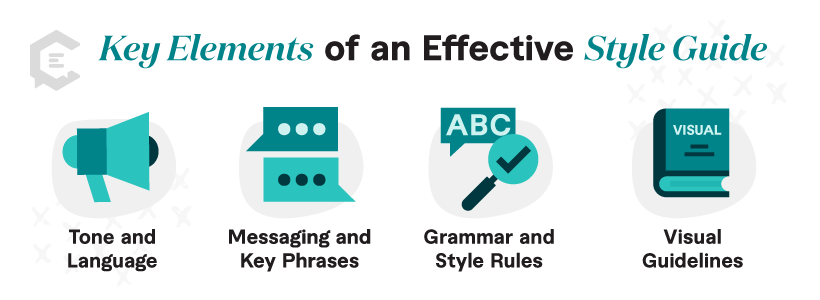Disney, McDonalds, My Little Pony, Pepsi, and Toyota have something in common. According to research, even preschoolers aged 3-5 have no trouble recognizing them via their brand symbols — a clear illustration of the power of branding.
But logos and symbols are just one aspect of branding. Your brand voice is another, and it can get lost in the shuffle if you’re outsourcing content creation.
In this guide, we explore:
- The importance of brand consistency in content outsourcing
- How to develop a comprehensive style guide
- How to communicate your brand’s voice to external creators
- Best practices for aligning outsourced content with your in-house content strategy
- How to resolve content outsourcing challenges

The Importance of Brand Consistency in Outsourced Content
Brand consistency equals brand recognition. With consistency, consumers learn to associate specific attributes with a brand, whether it’s the logo, color scheme, tagline, or communication style.
This means voice consistency cannot be an afterthought no matter who’s working on your content—your internal team, a content agency partner, or independent contractors.
Impact on customer perception and trust
Imagine a fashion brand known for its vibrant, youthful voice suddenly sporting a terse, almost scary tone in social media posts. You’d probably think their accounts got hacked. Or someone with a weird sense of humor is having a bad day and fired all the copywriters on the spot.
We can speculate for days, but one thing is certain: Brand inconsistency is bad news. Customers get confused, and you lose your chance to indelibly imprint the attributes you want people to remember about your brand. Worst-case scenario, they lose trust in your ability to deliver consistently memorable experiences.
This is where a style guide becomes critical.
Developing a Comprehensive Style Guide
A style guide, also known as a branding guide, is a document that details how your brand should be presented when writing and designing content. It provides clear instructions on how to align content with the brand’s distinct characteristics to maintain brand consistency.
Key elements of an effective style guide
A good style guide has the following core components:
- Tone and language: Your preferred tone and language must reflect your brand’s personality. For example, formal and professional vs. playful and whimsical.
- Messaging and key phrases: Include messaging representing your brand’s values and unique selling proposition. For example, use a “customer-first approach” or “tailored solutions” to emphasize your brand’s commitment to excellent service.
- Grammar and style rules: Establish rules for grammar, punctuation, and writing style. For example, if you prefer not to use the Oxford comma, put that in the style guide.
- Visual guidelines: Provide clear instructions on how to use logos, typography, color palettes, and imagery. Show them in various contexts. For example, high-resolution lifestyle images on website banners vs. product-focused images with minimal background distractions in printed materials like brochures.
While brand voice refers primarily to the personality, tone, and style of written or spoken communication, visuals are part of a broader concept known as “brand identity.”
Some things to note to ensure you’re presenting your style guidelines clearly and comprehensively:
- Real-life examples: Provide concrete examples that illustrate each guideline. These serve as tangible references for content creators to weave into their own work.
- Dos and don’ts: Include a “dos and don’ts” section to emphasize common mistakes to avoid. For example, avoiding idiomatic expressions that may be culturally insensitive or unclear to a broader audience.
- Scenarios and contextual guidance: Provide guidance on how to approach different scenarios. For example, using emojis on social media is okay, but not in blog posts or white papers.
Ensuring accessibility and understanding for external teams
You don’t want content creators to misunderstand your style guide, particularly external collaborators who may also be working with other clients. That said, consider the following additional recommendations:
- Provide clear explanations: Avoid jargon and provide context.
- Incorporate visual aids or infographics: Visual elements enhance comprehension and serve as quick references.
- Make your style guide digitally accessible: Consider creating an online, interactive version modular in structure and with search functionality.
Communicating Brand Voice to External Creators
Before writers write a single word, they must understand your brand voice. Get them acquainted with your style guide. Take the time to communicate your expectations. This way, you empower them to create content that resonates with your target audience while maintaining brand consistency.
Onboarding and training sessions
Onboarding sessions are perfect for sharing insights into your brand’s history and values, while interactive training sessions provide creators with hands-on experience with the brand voice.
Regular check-ins and feedback loops
Communicate, communicate, communicate. Establish regular check-ins and feedback loops to address uncertainties or inquiries. Ongoing dialogue ensures external team members maintain brand consistency and stay aligned with any changes in your brand voice.
Best Practices for Integrating Outsourced Content
Outsourced content has to seamlessly align with in-house strategies. Here are some best practices:
Editorial oversight and quality checks
Outsourced content has to undergo a review process to determine if it follows your style guide. Appoint an internal editor to conduct regular checks and provide constructive feedback.
Collaborating for brand consistency
Encourage collaboration between internal and external teams. Make collaboration easy by providing the environment and tools necessary to share insights, ask questions, and get things done together.
Tools you can implement include Asana or Trello for project management, Zoom or Microsoft Teams for virtual meetings, and Google Workspace or Microsoft 365 for document sharing.
Overcoming Challenges in Outsourcing Content
Content outsourcing done right provides many benefits, including access to specialized skills and cost and time savings. But you may encounter challenges along the way. The most common are misalignment and communication gaps.
Misunderstandings and misalignment typically stem from poor communication, which is why, as you will notice, the tips below have been discussed in previous sections. This underscores their importance not just in communicating guidelines but in resolving issues as well.
Resolving misunderstandings and mismatches
When content creators misunderstand your brand voice requirements, the result is a mismatch in the output.
- Establish clear communication channels: Facilitate dialogue between teams. Use collaboration and communication platforms to ensure ongoing communication.
- Schedule regular check-ins: Conduct regular meetings — even daily standups, if needed — to discuss potential misunderstandings and resolve any issues immediately.
- Provide a comprehensive style guide with examples: Make your style guide difficult to misinterpret. Provide examples illustrating the desired language and tone.
Adapting to evolving brand needs
Brands evolve, and external teams must stay updated with any changes in brand voice.
- Organize training sessions: If you’re changing your tagline or introducing a new mission statement, for example, conduct virtual training sessions to explain the changes. This helps your external team understand not just the whats but also the whys.
- Make brand updates easily accessible: Provide updates in the form of email newsletters your teams can easily go back to at any time. Alternatively, dedicate a section in your shared platform for updates.
- Host interactive workshops on brand evolution: Conduct workshops to discuss how your brand is evolving and how this affects content creation. Make them interactive so teams can actively participate, ask questions, and share their insights.
Preserving Brand Consistency in Content Outsourcing
Branding consistency equals brand recognition. External collaborators come from diverse backgrounds and have differing perspectives. Establishing clear guidelines is just the first step to ensure they create content that aligns with your brand strategies and expectations. The next is consistently enforcing those guidelines through reviews, regular communication, and periodic training sessions.
ClearVoice offers tailored content solutions that safeguard your brand voice while tapping into the collective creativity of experienced freelancers. To learn more, connect with us today.







